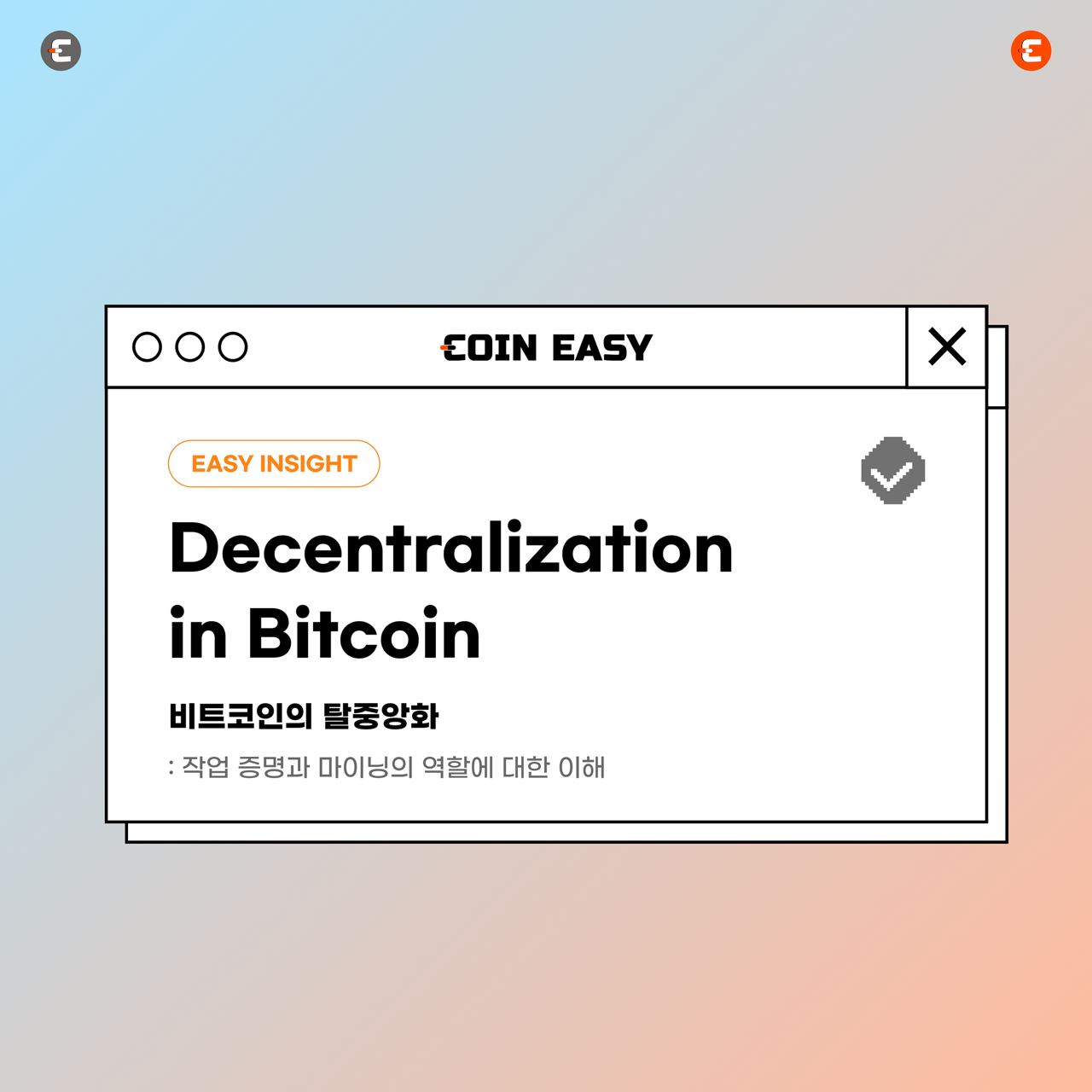 링크가 복사되었습니다.
링크가 복사되었습니다.




개요
비트코인의 주요 가치 제안은 탈중앙화 특성에서 비롯됩니다. 그러나 탈중앙화는 네트워크에 다양한 참여자가 있을 때만 효과적입니다. 비트코인 네트워크의 중요한 참여자 중 하나는 네트워크 보안을 돕는 채굴자입니다. 이러한 마이너들은 종종 “마이닝 풀”을 형성합니다. 그러나 두 개 이상의 마이닝 풀이 비트코인 총 해시 비율의 50% 이상을 제어할 경우 중앙 집중화에 대한 우려가 제기됩니다. 이 글에서는 비트코인의 인센티브 구조, 마이닝 풀의 작동 방식, 마이닝 풀에 대한 이해를 완전히 바꿀 수 있는 새로운 마이닝 프로토콜로 인해 이 문제가 지속될 가능성이 낮은 이유에 대해 살펴보겠습니다.
비트코인 마이닝이란 무엇인가요?
비트코인 네트워크는 단일 통제 주체가 없는 탈중앙화된 네트워크입니다. 따라서 모든 참여자가 원장의 실제 상태, 즉 모든 비트코인 거래의 기록에 동의하기 위해서는 합의 메커니즘이 필요합니다. 이러한 합의 메커니즘을 “작업 증명”이라고 하며, 수행되는 작업을 마이닝이라고 합니다.
기존 회계 원장과 달리 비트코인 원장은 거래를 가상의 “블록”으로 묶습니다. 이러한 블록은 작업 증명 메커니즘을 통해 서로 연결되어 “블록체인”을 형성합니다. 비트코인은 이 채굴 과정에서 해시 함수를 사용합니다. 해싱은 모든 입력을 표준화된 출력으로 변환합니다. 핵심 기능은 출력을 보고 입력을 해독할 수 없다는 것입니다.
비트코인은 SHA-256 해시 알고리즘을 사용하여 새로운 블록을 생성합니다. 채굴자는 비트코인 프로토콜의 지정된 “목표” 범위와 일치하는 해싱 출력을 생성해야 합니다. 해싱에 성공하면 채굴자는 새로운 블록을 블록체인에 추가할 수 있는 권한을 부여받으며, 네트워크에서 보상과 사용자 수수료로 인센티브를 받게 됩니다.
비트코인의 전력 사용량과 인센티브
해싱의 단방향 특성을 고려할 때, 정확한 출력을 얻으려면 상당한 시행착오가 필요합니다. 채굴자는 올바른 출력을 찾기 위해 수조 개의 무작위 해시 입력을 시도해야 합니다. 이를 위해서는 상당한 양의 전기가 필요하며, “작업 증명”을 통해 디지털 영역과 물리적 세계를 연결해야 합니다. 가장 먼저 ‘퍼즐’을 푸는 채굴자가 블록체인에 글을 쓸 수 있는 권한을 얻게 됩니다.
독재 제한
채굴은 채굴자에게 상당한 권한을 부여하지만, 비트코인 프로토콜에는 채굴자가 네트워크의 최선의 이익에 부합하도록 유지하기 위한 인센티브가 포함되어 있습니다. 여기에는 블록 보상과 채굴 수수료가 포함됩니다.
그러나 채굴자가 트랜잭션을 무시하거나 선택적으로 선택하여 블록을 검열할 가능성은 항상 존재합니다. 하지만 동일한 채굴자가 두 블록을 연속적으로 해결할 가능성은 낮기 때문에 검열이 지속될 가능성은 낮습니다.
해시레이트의 75%가 트랜잭션 검열에 맞춰져 있고 사용자가 경쟁력 있는 수수료로 트랜잭션을 전송했다면, 해당 트랜잭션은 한 시간 이내에 채굴될 가능성이 높습니다. 평균적으로 정직한 채굴자가 적어도 하나의 블록을 발견할 수 있기 때문입니다. 따라서 51% 공격은 네트워크를 완전히 검열하지 못하며, 다른 채굴자가 여전히 트랜잭션을 포함하기 때문에 완전히 무용지물이 될 수 있습니다. 이는 프로토콜의 검열 저항성을 유지합니다.
결론
비트코인 프로토콜은 채굴자에게 상당한 권한을 부여하지만, 그 권한의 오용을 방지하는 규칙도 부과합니다. 채굴자는 비트코인의 총 공급 한도나 신규 발행량을 변경할 수 없습니다. 과거 블록은 변경할 수 없으며, 부패한 독재자가 할 수 있는 최악의 행위는 현재 블록에 대한 거래를 검열하는 것뿐입니다. 검열은 대략 10분마다 정직한 독재자가 선출되는 즉시 종료됩니다. 따라서 비트코인의 가치 제안, 즉 진정으로 탈중앙화되고 안전하며 변조가 불가능한 네트워크는 그대로 유지됩니다.
Decentralization in Bitcoin: Understanding Proof of Work and the Role of Mining
Introduction
Bitcoin’s primary allure is its decentralized character. This decentralization is reliant on a diverse network of participants. One of the most critical groups within the Bitcoin network is the miners, entities or individuals that expend electricity and computing power to secure the network. They often come together to form “mining pools.”
The Centralization Problem
Currently, two major mining pools control over 50% of Bitcoin’s total hash rate. This trend towards centralization, and the potential for censorship from mining pool operators, is a concern. In this article, we argue that this issue is unlikely to persist, thanks to Bitcoin’s incentive structure, the nature of mining pools, and upcoming mining protocols that could radically redefine our conception of mining pools.
Understanding Bitcoin Mining
The Bitcoin network is a decentralized system where no single person or entity has control. Consequently, the network requires a consensus mechanism that enables participants to agree on the ledger’s true state. A crucial part of this consensus mechanism is known as “proof-of-work”.
The Blockchain Concept
Proof-of-work is the task performed by miners to secure the blockchain and mint new bitcoin tokens. Transactions are organized into virtual “blocks” which are linked to the next block, forming what is known as a “blockchain.” This process makes it verifiable and secure.
The Role of Hashing
Creating new blocks and adding them to the blockchain involves a process called “hashing.” Hashing is a one-way function that produces a randomized, standard-sized output for any input. Bitcoin uses this concept in its mining process by hashing the last block added to the blockchain and using this hashed data as an input for the next block.
Bitcoin’s Electricity Usage and Incentives
Finding the right hash is a trial-and-error process. It requires a vast amount of electricity, which translates to the physical world’s proof-of-work. This process is incentivized with rewards and user fees, effectively tying the digital world to the physical one.
Limiting the Dictatorship
Solving the mining puzzle gives the miner write access to the blockchain. To prevent misuse of this power, the protocol has inbuilt incentives to act in the network’s best interest. The miner is rewarded with block rewards and transaction fees from users.
Conclusion
Even with a 51% attack, complete censorship is unlikely, and transactions can still be included by other miners. This provides Bitcoin with its censorship resistance. A miner cannot alter the future supply of bitcoin or issue themselves more bitcoins than allowed. The worst a corrupt miner could do is censor transactions for the current block. But even this comes to an end when an honest miner is selected, approximately every ten minutes.
📍더 알아보기 : https://t.me/coiniseasy
📍코인이지 앱 :
IOS- https://apps.apple.com/us/app/coineasy/id6463145391
Andoid - https://play.google.com/store/apps/details?id=com.coineasy.coineasy
레퍼런스: 1075400.1.0-Bitcoin Keeping Proof of Work Decentralized (FINAL).pdf (fidelitydigitalassets.com)
댓글 60개


제이에스
2024.01.08 12:46:11
감사합니다.


코인이지
2024.01.08 18:04:27
감사합니다


FADO
2024.01.04 10:55:23
오늘도 좋은정보 유익한 뉴스들 감사합니다


코인이지
2024.01.04 17:21:31
감사합니다


러너일이
2024.01.03 12:54:58
잘 봤습니다.


코인이지
2024.01.04 17:21:32
감사합니다


FADO
2024.01.03 11:33:32
오늘도 좋은 뉴스와 정보들 감사합니다


코인이지
2024.01.04 17:21:33
감사합니다


릴라당
2024.01.03 07:59:05
잘보고갑니다


코인이지
2024.01.04 17:21:34
감사합니다








































2023.12.26 16:32:12